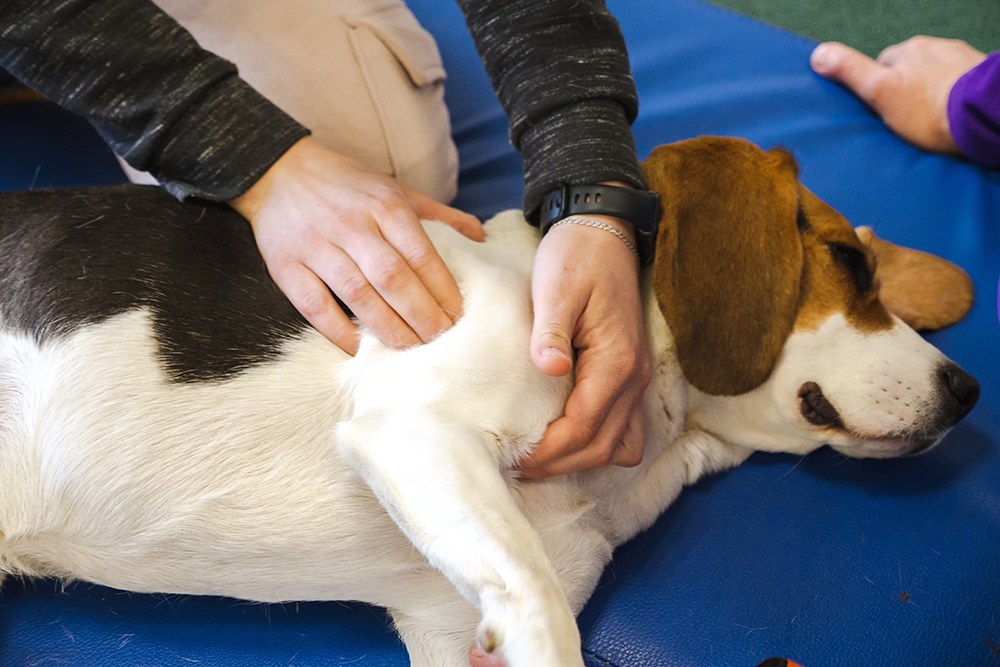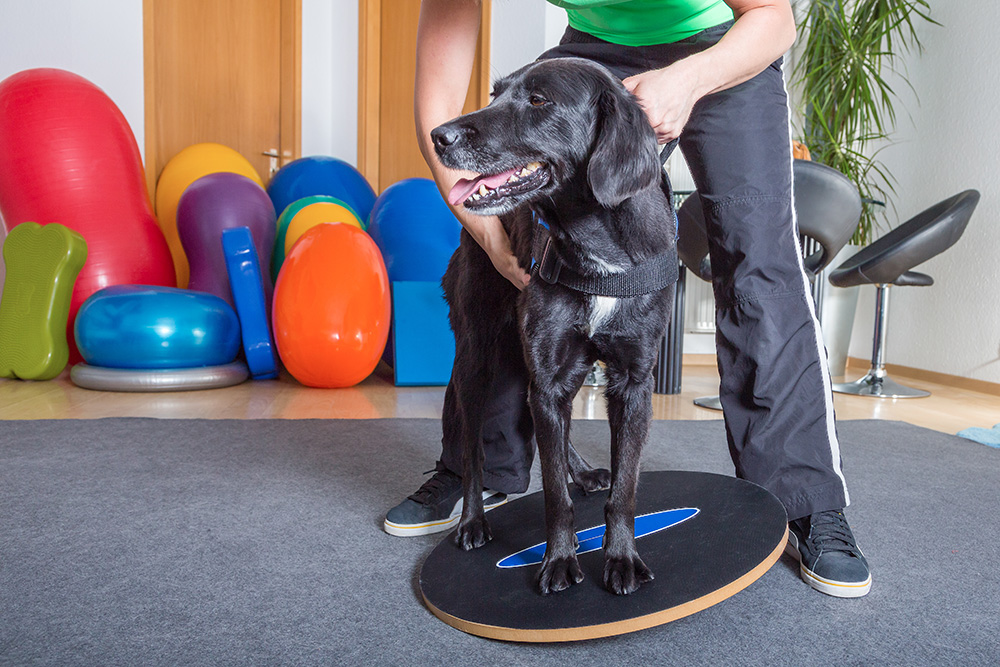Physiotherapy for dogs and cats
Overview
- Physiotherapy can be used to help treat many injuries and conditions including rehabilitation after surgery, helping pets recover from an injury or if they have a condition that limits their movement, such as arthritis.
- Physiotherapy aims to reduce pain, improve movement and restore normal muscle function in your pet.
- Our vets have put together this information to help you understand when your pet might need physiotherapy, and how to choose an appropriate physiotherapist for your pet.
What is physiotherapy?
Physiotherapy for your pet can be called animal or veterinary physiotherapy. It involves a range of techniques such as massage, trigger point release (gentle massage that releases tense painful knots), and controlled exercise and movements. It can be used to help relieve pain, improve movement, and speed up recovery from injury.
Physiotherapy is used alongside veterinary care to help in the treatment or long-term management of many different injuries and conditions relating to muscles, tendons, ligaments, bones, joints and nerves. It can also be used to improve and maintain working and competing dog performance.


When is physiotherapy used in pets?
Physiotherapy can be used for:
Rehabilitation after an operation
Physiotherapy can be used to help pets recover from operations on muscles, bones, tendons, and ligaments. For example, after surgery for a cruciate ligament injury, or patella luxation. It can be used before an operation, to help prepare, or afterwards, to help aid with recovery.
Long term pain and movement problems
Physiotherapy can be used to keep older pets mobile, and also to help pets with long-term conditions such as arthritis stay as comfortable, pain free and active as possible. It can also be used to help pets with neurological conditions such as a Slipped disc (IVDD) or Degenerative myelopathy (DM).
Injuries and pain relief
Physiotherapy might be suitable if your pet has sustained an injury that doesn’t require surgery but is affecting a muscle, tendon, or ligament. It can help to relieve pain and discomfort and restore normal function.
Working or competing dogs
Physiotherapy can be used to enhance the performance of a working or competing dog.
How to access veterinary physiotherapy
If you feel your pet may benefit from physiotherapy, the first thing to do is to talk to your vet, who will refer them if appropriate. They may request that you bring your pet in for a check up to ensure its right for them.
By law, physiotherapists, chiropractors and osteopaths must have a vet’s permission before treating any animal. This is to make sure that your pet receives the safest and most effective treatment. Referral to a physiotherapist early on is best, as it’s important to prevent issues worsening and promote quality healing.
How to find a veterinary physiotherapist
The titles ‘Animal Physiotherapist’ and ‘Veterinary Physiotherapist’ aren’t protected, which means anyone can use them, regardless of their qualifications. So, our vets recommend finding a pet physiotherapist who has qualified via a recognised training programme, and, as a result, has the letters BSc, MsC or PgDip after their name. Your chosen physiotherapist should also be a member of one of the governing bodies listed below - this proves they are properly qualified and insured. The main governing bodies in the UK are:
- ACPAT (Association of Chartered Physiotherapists in Animal Therapy): members have a degree in human physiotherapy followed by further training in animal or veterinary physiotherapy. Only human trained physiotherapists can use the protected term ‘chartered’.
- NAVP (National Association of Veterinary Physiotherapists): members will have postgraduate training in animal physiotherapy; and usually have prior experience at undergraduate level in animal science, veterinary nursing or veterinary medicine.
- IRVAP (The Institute of Registered Veterinary & Animal Physiotherapists)
- RAMP (Register of Animal Musculoskeletal Practitioners)
- AHPR (Animal Health Professionals Register)
Always ask any potential physiotherapist about their insurance before committing to your pet’s first appointment.
What to expect at your pet’s physiotherapy appointment
Some physiotherapists work from their own clinic, some are based in a veterinary practice, and others offer home visits. Facilities at your physiotherapist’s clinic should be well maintained, clean and dry. They may also have non-slip flooring. There are various pieces of equipment that can be used to help with range of motion, balance, strengthening, and core work such as foam, wobble cushions, poles, peanut balls, platforms, ramps, and steps.
Your physiotherapist can also advise you on changes that can be made to your pet’s home environment that will help them move around more easily. For example using rugs on slippery floors and having ramps or steps to access the sofa.
Cost
Physiotherapy sessions can vary in cost, so it’s best to ask your physiotherapist how much they are charging before starting treatment. It’s important to speak openly to your physiotherapist about your finances.
Many pet insurance policies cover physiotherapy treatment. However each company is different and it will depend on the policy you have - check with your insurance company what your pet’s individual policy covers before starting treatment. Your insurance company may also specify that your physiotherapist will need to be registered with certain governing bodies.
- How long does a physiotherapy session last?
- How many treatments will my pet need?
- Can my pet see a physiotherapist without referral from my vet?
- Will physiotherapy hurt my pet or stress them out?
- How can I get my pet to do the exercises?
- Can my human physiotherapist treat my dog?
- Can my pet have physiotherapy at home?
How long does a physiotherapy session last?
Pet physiotherapy sessions usually last 30-60 minutes.
How many treatments will my pet need?
Every pet is different, your pet will need to be assessed by their physiotherapist, who will create a treatment program tailored to them. Some problems can be sorted in one visit but most require a course of treatment i.e. multiple sessions. Long term conditions may require ongoing treatment for example once every two to four weeks. Your physio may also give you some exercises to do with your pet at home between appointments.
Can my pet see a physiotherapist without referral from my vet?
No, by law your physiotherapist must have your vet’s permission before treating your pet. It’s important that they are fully aware of your pet’s medical history, and create a treatment plan together with your vet.
Will physiotherapy hurt my pet or stress them out?
There is nothing throughout the treatment that will cause your pet pain. If your pet is worried or stressed, your physiotherapist will take things slowly and allow your pet to get used to the treatment. Many pets (including cats) relax and enjoy the treatment.
How can I get my pet to do the exercises?
It’s likely that your physiotherapist will give your pet exercises to do at home between sessions. This aims to help speed up recovery and helps with long term management. The best way to encourage your pet to do their exercises is by giving them lots of positive reinforcement (encouragement and treats) during, and after each set of exercises. Remember, to count any treats as part of your pet’s daily calorie allowance so they don’t gain weight.
Can my human physiotherapist treat my dog?
Human physiotherapists must complete a postgraduate qualification in animal or veterinary physiotherapy before treating any animal. They will have the letters BSc, PgDip or MSc after their name and will usually be registered with ACPAT.
Can my pet have physiotherapy at home?
Yes, some physiotherapists provide an at-home service which can be beneficial to pets that struggle to adjust to new environments.
Published: January 2024
Did you find this page useful?
Tell us more
Please note, our vets and nurses are unable to respond to questions via this form. If you are concerned about your pet’s health, please contact your vet directly.
Thank you for your feedback
Want to hear more about PDSA and get pet care tips from our vet experts?
Sign up to our e-newsletter
Written by vets and vet nurses. This advice is for UK pets only. Illustrations by Samantha Elmhurst.
